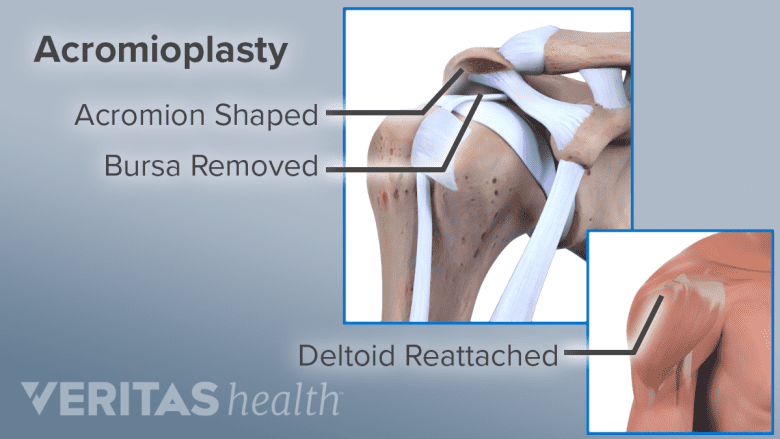Shoulder surgery is typically recommended when shoulder bursitis is chronic and related shoulder impingement. The type of surgery performed will depend on the patient’s symptoms and the underlying cause of the shoulder pain.
In This Article:
The 3 surgical procedures typically recommended include:
Bursectomy
The inflamed bursa is removed in a procedure called a bursectomy. This may be done with a single open incision or arthroscopically (which requires 2 or 3 small incisions).
After a bursa is removed, a new bursa may form in its place. The hope is that the newly formed bursa is less prone to irritation and causing painful symptoms.
Subacromial Decompression (Acromioplasty)
Acromioplasty involves removing bone tissue to make room for soft tissue.
During subacromial decompression the surgeon removes or shaves down part the shoulder blade’s acromion. By removing bone tissue, the surgeon creates more space for the shoulder’s soft tissues, including the rotator cuff, tendons, and the subacromial bursa.
The hope is that by giving these soft tissues more space they will be less likely to become irritated and inflamed and create painful symptoms. Removing bone does not typically affect the shoulder joint’s long-term function.
This surgery is most likely to be recommended if the acromion is curved or hook-shaped (as opposed to flat), as experts believe these shapes increase the likelihood for impingement.
Tendon and Muscle Repair
When shoulder bursitis or impingement is caused by damage to a rotator cuff muscle or tendon, a doctor may recommend surgery to correct the damage. For example, a torn tendon may be repaired and reattached to the humeral head.
Some experts believe the majority shoulder bursitis cases originate from tears in the rotator cuff muscles.1van Holsbeeck & Strouse. Sonography of the shoulder: evaluation of the subacromial-subdeltoid bursa. AJR Am J Roentgenol. 1993 Mar;160(3):561-4. PubMed PMID: 8430553.
Deciding if Surgery Is Necessary
Subacromial decompression is often done along with a bursectomy; however, there is evidence that suggests bursectomy alone may be just as effective as a bursectomy and subacromial decompression.2Donigan JA, Wolf BR. Arthroscopic subacromial decompression: acromioplasty versus bursectomy alone--does it really matter? A systematic review. Iowa Orthop J. 2011;31:121-6. PubMed PMID: 22096430; PubMed Central PMCID: PMC3215124.,3Kolk A, Thomassen BJW, Hund H, de Witte PB, Henkus HE, Wassenaar WG, van Arkel ERA, Nelissen RGHH. Does acromioplasty result in favorable clinical and radiologic outcomes in the management of chronic subacromial pain syndrome? A double-blinded randomized clinical trial with 9 to 14 years' follow-up . J Shoulder Elbow Surg. 2017 Aug;26(8):1407-1415. doi: 10.1016/j.jse.2017.03.021. Epub 2017 May 8. PubMed PMID: 28495574.
Moreover, some experts suggest that nonsurgical treatments are appropriate in most cases. More research is needed in this area. The exception is when bursitis and shoulder impingement are caused by rotator cuff tears; in these cases, experts seem to agree that surgery to repair the rotator cuff is appropriate.4Consigliere P, Haddo O, Levy O, Sforza G. Subacromial impingement syndrome: management challenges. Orthop Res Rev. 2018;10:83–91. Published 2018 Oct 23. doi:10.2147/ORR.S157864
After surgery, the patient may be asked to wear a sling for a set period of time and participate in physical therapy.
- 1 van Holsbeeck & Strouse. Sonography of the shoulder: evaluation of the subacromial-subdeltoid bursa. AJR Am J Roentgenol. 1993 Mar;160(3):561-4. PubMed PMID: 8430553.
- 2 Donigan JA, Wolf BR. Arthroscopic subacromial decompression: acromioplasty versus bursectomy alone--does it really matter? A systematic review. Iowa Orthop J. 2011;31:121-6. PubMed PMID: 22096430; PubMed Central PMCID: PMC3215124.
- 3 Kolk A, Thomassen BJW, Hund H, de Witte PB, Henkus HE, Wassenaar WG, van Arkel ERA, Nelissen RGHH. Does acromioplasty result in favorable clinical and radiologic outcomes in the management of chronic subacromial pain syndrome? A double-blinded randomized clinical trial with 9 to 14 years' follow-up . J Shoulder Elbow Surg. 2017 Aug;26(8):1407-1415. doi: 10.1016/j.jse.2017.03.021. Epub 2017 May 8. PubMed PMID: 28495574.
- 4 Consigliere P, Haddo O, Levy O, Sforza G. Subacromial impingement syndrome: management challenges. Orthop Res Rev. 2018;10:83–91. Published 2018 Oct 23. doi:10.2147/ORR.S157864


